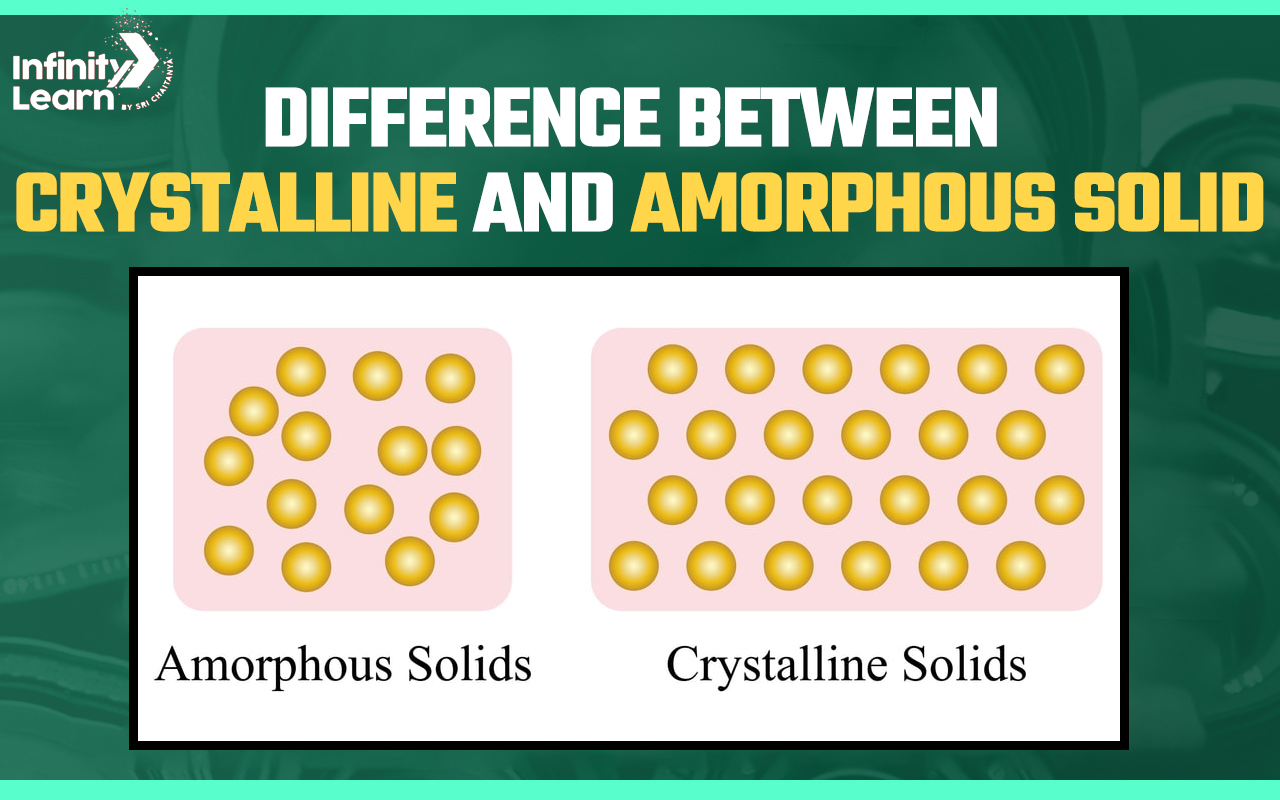Table of Contents
Matter is classified into three different states: solids, liquids and gasses. There are two states of solids which are amorphous and crystalline. Now, these states of solids depend upon the geometry of the particles, whether they are arranged in a definite or indefinite geometry.
In this article, we will learn about solids and their two types also the difference between Crystalline and Amorphous solids.

Definition of Solids
A solid is a state of matter with definite mass, shape and volume. For example, stone, wood, etc. These are incompressible if a force is applied to them. Sound speed is faster in solids as compared to liquids and gasses.
Intermolecular distance is less between the particles of solids. And the intermolecular forces are very strong. Solids are rigid.
Based on the arrangement of constituent particles, solids are classified into two types:
- Crystalline solid
- Amorphous solid
Crystalline Solids
The particles of crystalline solids are arranged in a three-dimensional manner. Intermolecular forces are equal between the particles. The melting point of crystalline solids is sharp. They are anisotropic. Crystalline solids are called true solids. For example – diamond, copper, etc.
Properties of Crystalline Solids
- Crystalline solids have high melting points and they begin to melt at a specific temperature.
- Shape and arrangement in crystalline solids is well defined.
- Cleavage property – It means when cut with the knife, the new surface obtained will be smooth and plain.
- Crystalline solids are anisotropic, meaning they have physical properties such as electrical resistance refractive index.
- They are true solids.
Types of Crystalline Solids
Crystalline solids are classified into 4 types:
- Ionic: The particles from which ionic solids are formed are ions. Example – NaCl (table salt)
- Molecular: The particles in these solids consist of molecules. They are held together by Vander Waals forces. Example – Ice
- Covalent: In covalent solids, particles are held together by covalent bonds arranged in a 3D arrangement. For example – diamond
- Metallic: Metallic solids are those solids in which properties of metals are found. For example – silver, tin etc.
Amorphous Solids
Amorphous solids are shapeless. There is an irregular arrangement of solid particles. Intermolecular forces between the particles are not equal. The geometric shape is undefined. The distance between particles is more. These solids are also known as supercooled liquids. Amorphous solids are isotropic. For example – glass, plastic etc.
Properties of Amorphous Solids
- Amorphous solids can become soft if heated to a certain temperature range.
- They can be moulded into different shapes when heated.
- They have irregular shapes because of the irregular arrangement of solid particles.
- Irregular surfaces are formed if cut with a sharp knife.
- They are pseudo solids.
- Amorphous solids are isotropic.
Difference Between Crystalline and Amorphous Solid Class 9
A crystalline solid is formed by arranging the particles of a solid in a three-dimensional manner repeatedly, whereas amorphous solids are formed by an irregular arrangement of atoms. Crystalline solids have high melting points, whereas amorphous solids don’t have a high melting point.
Crystalline solids cannot change their shape if applied a little force whereas amorphous solids can change their shape if applied less force. Crystalline solids have well-defined edges and faces, whereas amorphous solids don’t. Crystalline solids are anisotropic in nature, whereas amorphous solids are isotropic.
Difference Between Crystalline and Amorphous Solid
| Difference between Crystalline and Amorphous Solid | |
| Crystalline | Amorphous |
| Crystalline solids are arranged in a three-dimensional manner. | Amorphous solids are shapeless. There is an irregular arrangement of solid particles. |
| They have high melting points | They do not have high melting points. |
| Crystalline solids have a plane, centre and axis of symmetry. | Amorphous solids do not have any kind of symmetry. |
| They are hard and rigid, if applied with mild force, will not change their shape | They are not rigid, so by applying small force, they may change their shape. |
| Crystalline solids, when cut with a knife, give clean and smooth edges. | Amorphous solids form diffused and irregular edges when cut with a knife. |
| They are anisotropic. | They are isotropic. |
| These are known to be true solids. | These are known as pseudo-solids. |
| Crystalline solids have a definite heat of fusion. | Amorphous solids don’t have a specific heat of fusion. |
| These are long-range orders with a fixed arrangement that is applicable throughout the material. | These are not long-range orders, particles are randomly arranged. |
| For example, salt, diamond, copper, gold etc. | For example: glass, rubber, plastic, quartz. |
These were some differences between amorphous and crystalline solids.
The difference between amorphous solids and crystalline solids is based on their structural arrangement and physical properties as well.
Crystalline solids have a perfectly ordered atomic structure, while amorphous solids do not have an ordered structure. Crystalline solids are more dense than amorphous solids. The melting point of crystalline solids is higher than that of amorphous solids.
Talking about the structure, the internal structure of crystalline solids is well-defined whereas in amorphous solids, the internal structure is brittle.
FAQs on Difference Between Crystalline and Amorphous Solid
Define crystalline solids?
Crystalline solids are composed of ions, molecules and atoms arranged in a regular three-dimensional manner repeatedly.
Why is glass known to be a supercooled liquid?
Glass is known to be a supercooled liquid because it has some properties of liquid as well. It is slightly thicker at the bottom.
Write a point of difference between Crystalline and Amorphous solids on the basis of melting point
Crystalline solids have high melting points, and they only melt at a specific temperature. Amorphous solids don't have a high melting point. They soften gradually over a temperance.
Give examples of crystalline and amorphous solids.
Crystalline solids: salt, diamond, copper, gold Amorphous solids: glass, rubber, plastic, quartz









